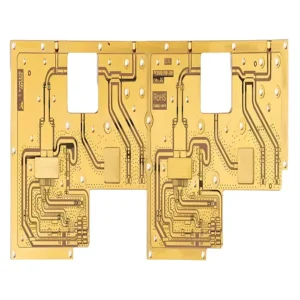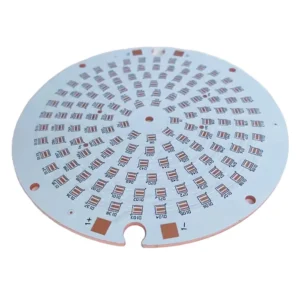Teflon RF Microwave PCB
$55.90
Teflon(PTFE) RF microwave PCB is the circuit board that is made of PTFE-based laminates. Such boards are particularly designed for applications where signals are to be transmitted on high frequencies because they deliver top-notch electrical properties and minimum loss of signals to ensure superior performance.
Shipping fee and delivery date to be negotiated. Send inquiry for more details.
Your payment information is processed securely. We do not store credit card details nor have access to your credit card information.
Claim a refund if your order is missing or arrives with product issues, our support team would deal with your refund within 24 hours.
| Layer Counts | 4L |
| Base Material | Rogers |
| Board Thickness(mm) | 1.6mm |
| Max board size(mm) | 570*850mm |
| PCB size tolerance | ±0.2mm |
| Min. Hole Size | 0.15mm |
| Min. Line Width | 4mil |
| Copper Weight | 1oz |
| Surface Finish | ENIG |
| Certificate | UL, RoHS, ISO, ISO9001, ISO13485, IPC610, and REACH |
 Teflon RF Microwave PCB
Teflon RF Microwave PCB
| 5 star | 0% | |
| 4 star | 0% | |
| 3 star | 0% | |
| 2 star | 0% | |
| 1 star | 0% |
Sorry, no reviews match your current selections
Questions & Answers
1. What is the shipping port?
We ship the goods via the Port of Hong Kong or Shenzhen.
2. What are your payment terms?
T/T, Paypal, Western union, L/C ,ESROW.
3. What causes insertion loss in RF PCBs?
The insertion loss in RF PCB is mainly caused by 3 factors: conductor loss(copper roughness and skin effect), dielectric loss, and radiation loss(impedance mismatches).
4. Why is Teflon PCB drilling more difficult than FR-4?
PTFE is a soft material, and this property may cause smearing and deformation instead of clean cuts. Besides, the low thermal conductivity of PTFE can lead to heat buildup, melting the material, and clogging drill bits. Rigid FR4 with effective heat dissipation makes it easier to form a chip and clean the hole.
5. What are the differences between PTFE and ceramic-filled PTFE?
Pure PTFE is a soft polymer that is ideal for high-frequency PCBs but has low dielectric loss, poor thermal conductivity, and low wear resistance, making it easy to deform and difficult to machine. However, ceramic-filled PTFE incorporates additives that improve PCB’s mechanical rigidity, thermal stability, and wear resistance, making it more feasible for high-power RF and aerospace applications.
6. How do you ensure proper adhesion of copper to Teflon?
Proper copper adhesion to Teflon needs to roughen its naturally inert surface with plasma or chemical etching and special adhesion promoters. We also use thin adhesive films before plating.
7. What special handling in manufacturing is needed for PTFE PCB?
When manufacturing PTFE PCBs, it demands low-stress machining to avoid material deformation. It also needs controlled thermal cycles to prevent warping.
8. Why does PTFE need special through-hole pretreatment or operation procedures?
The PTFE is soft and non-stick, making its hole walls hard to plate. The pretreatment of Plasma etching or sodium etching is mandatory to prevent risks of cracking or barrel pulls during thermal cycling, especially in high-reliability RF/military applications.
9. How does temperature affect Teflon PCBs? What temperature is better for Teflon?
PTFE starts to soften above 260°C and melts at 327°C, and prolonged exposure to >200°C may cause creep and CTE mismatches. For long-term PCB operation, the temperature had better be kept under 150°C.







